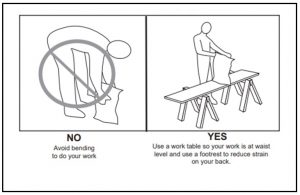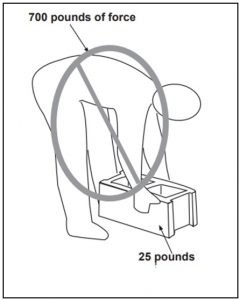Picture This: Lift with…Care?
https://i.redd.it/kfsxkt04lhgz.jpg
I’ll be the first to admit I’ve seen this image before, but I never gave any thought to just how misleading it is. Most of us know to lift with our legs and not our backs – quite the opposite of what this label is showing us to do. And even though we know the right way to lift, it’s likely most of us don’t always practice it.
Manually moving materials is one of the quickest and the most prevalent way to injure your back. Back injuries are painful for the worker and costly for the employer. To reduce back injuries at work, it is important to find and avoid risk factors that increase the chance of injury.
Share the following with your workers, stop and correct any lifting or moving being done in an unsafe way, and remind them frequently of the right way to lift and move materials.
When any of the following occur in combination your risk of a back injury is increased:
- Awkward posture
- Overexertion
- Repetition
- Fatigue
Awkward Posture
Whether standing or sitting, there is a neutral position for your back. Postures that differ from the neutral position increase stress on the back, especially when combined with other risk factors.
- Strenuous activity while the body is in a twisted or bent position.
- Repeated bending, twisting and reaching.
- Bending forward while lifting.
Reduce Awkward Postures:
- Change the work height so you can handle the item with your back in a neutral position.
- Store materials at waist level to avoid bending to lift.
- Use material handling devices, such as dollies, carts, skid loaders and lift trucks.
- Bend the knees, not the back, to lift.
- Move your feet, instead of twisting, to move materials.
- Ask a coworker to assist your lift or divide the load.
Tasks that require forceful exertions place higher loads on the muscles, discs, ligaments and joints and can lead to fatigue and injury.
Your Risk Depends On:
- Type of grip
- Weight of an object
- Type and duration of the task
- Body posture
Reduce Overexertion:
- Use material handling devices, such as dollies, carts, wheel barrows, lift trucks and skid loaders.
- Divide the load for safer transport. 4Push materials rather than lift.
- Ask a coworker to assist your lift.
Fatigue
Job tasks that require the same muscles or motions for long durations can increase fatigue. In general, the longer the period of work, the longer the recovery or rest time required.
Reduce Fatigue:
- Alternate tasks and postures that use different motions and muscles groups, such as sitting and standing.
- Take time to stretch during scheduled breaks. 4Break standing tasks with seated.
Repeating the same motions over and over again places stress on muscles and joints. If repetitive motions are frequent or sustained and combined with excessive force or awkward postures, they can cause injury. Y
Your Risk Depends On:
- How often the action is repeated.
- Speed of the movement.
- Number of muscles involved.
- Required force to lift or move the material.
- Body posture.
Reduce Injury from Repetition:
- Alternate tasks and postures that use different motions and muscle groups.
- Take time to stretch during scheduled breaks.
- Use material handling devices, such as dollies, carts, skid loaders and lift trucks.
Source: https://www.osha.gov/dte/grant_materials/fy06/46g6-ht22/back_injury_prevention.pdf



